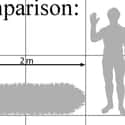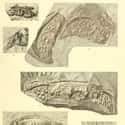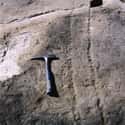(#3) It Measured Over Six Feet Long
Just how big was Arthropleura, anyway? If an average-height man lay down in the swamps of the Carboniferous Period, an adult Arthropleura could completely cover his body. Scholars believe Arthropleura grew at least two meters in length or the equivalent of over six-and-a-half feet.
They still haven't recovered a complete fossil from the creature, however, so it's possible the prehistoric millipede grew even larger.
(#14) Scientists Still Have A Lot Of Questions About It
While Arthropleura was first identified by scientists back in 1854, there are still many questions about the prehistoric millipede. For example, scientists know very little about the life stages of Arthropleura, including its larval stage. That's because only tracks and partial segments have been found, and scientists still lack a complete adult specimen. The creature's exact head structure also eludes scientists, because, in most fossil remains, the head and jaw area remains incomplete.
The best clues we have about the prehistoric creature come from its tracks, which have been found in numerous locations across Europe and North America. The tracks help establish Arthropleura's massive size, but can't shed light on its other mysteries.
(#7) Its Tracks Alone Show How Massive It Grew
During fossil excavations, scientists sometimes find fossilized tracks from ancient creatures; Arthropleura is no different. In 2001, Michael C. Rygel snapped a picture of the millipede's huge tracks, discovered in Nova Scotia.
The tracks don't just reveal the millipede's size - they also give some clues about the creature's habitat. Some of these prehistoric tracks show Arthropleura skittering around trees in the forests where it thrived.
(#10) It Shared Many Characteristics With Modern Millipedes
While it was much longer than today's millipedes, Arthropleura shared some important characteristics with its descendants. For one, it maintained the same ratio of body segments to pairs of legs. The creature had around 30 segments and approximately 40 legs. Like most modern millipedes, Arthropleura had nowhere near the thousand legs its name suggests.
The prehistoric millipede had a somewhat flattened shape, with plates running down the length of its body and side plates reaching out to protect its legs. These pieces often disintegrated after death, making it a challenge to reconstruct the creature with fossil records.

(#12) Giant Millipedes Are Unlikely To Return
Scientists believe one reason Arthropleura grew so large is because of the higher concentration of atmospheric oxygen about 300 million years ago. But physics means that giant millipedes even larger than Arthropleura are unlikely to plague the Earth.
As vertebrate paleontologist Hans Sues explains, as an arthropod, millipedes are limited by certain size constraints. The creature's exoskeleton means that an arthropod much larger than Arthropleura would not be able to walk due to the required thickness of the creature's leg tubes. And large arthropods also struggle to transfer oxygen throughout their body, which might be one reason Arthropleura vanished when oxygen levels decreased.
(#5) It May Have Been An Apex Predator
In addition to having no known predators, Arthropleura may have been a predator itself. In March Onto Land, author Thom Holmes dives into what the prehistoric millipede ate. While scientists believe Arthropleura likely dined on the decaying organic material that collected on the wet floors of the massive forest, it may have also enjoyed carnivorous meals.
In addition to consuming insects, scientists speculate it may have even hunted small vertebrates unlucky enough to cross paths with the enormous creature.
New Random Displays Display All By Ranking
About This Tool
The giant millipede is a kind of prehistoric animal, with a body length of up to 3 meters, and is one of the largest terrestrial arthropods in history. The giant millipede lived in the Carboniferous, because the climate was warm and welt at that time, and the oxygen content was more than 35%, the arthropods at that time could grow very huge. So far, there are more than 10,000 types of millipedes on the earth, and they are distributed all over the world.
The prehistoric giant millipedes are the ancestors of modern millipedes. It’s a pity that these large animals went extinct about 290 million years ago. You can find 14 facts about these prehistoric millipedes that were even not predators.
Our data comes from Ranker, If you want to participate in the ranking of items displayed on this page, please click here.














